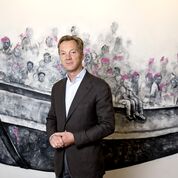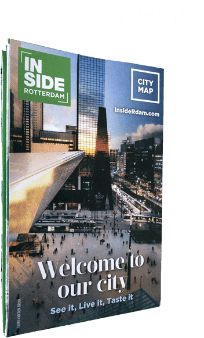‘Rotterdam on the verge of a third Golden Age’
Even though he was appointed director of the Rijksmuseum in Amsterdam, Wim Pijbes didn’t pack up and move there. He’s very attached to Rotterdam – now more than ever as director of a philanthropic foundation that aims to boost the city’s cultural capital.
Words: Ellen Scholtens
Photos: Bart Hoogveld

What would your ultimate ‘must-do’ suggestions be for tourists in Rotterdam?
‘That would depend on the tourist. I would suggest Witte de Withstraat for younger tourists; there’s a lot going on there, entertainment-wise. In and around Pannekoekstraat is also interesting, including Het Industriegebouw. I like architecture myself, something that Rotterdam excels in. I would suggest starting at the river Maas and working out a route from there. Don’t just walk into the centre and expect to come across interesting places. Rotterdam doesn’t instantly reveal itself to you. You don’t go out here – you go somewhere. It’s a bit like Milan or Hamburg in that respect. You have to discover Rotterdam; you have to be introduced to it. The best way is by water taxi. Catch one to the Merwehaven area, for example, and visit artist Joep van Lieshout’s studio. Definitely go to Kop van Zuid and to Katendrecht. Exciting places.’
Despite being appointed director of the Rijksmuseum in Amsterdam (which followed your eight-year stint as director of the Kunsthal) you continued living in Rotterdam.
‘That was for practical reasons. We have a fantastic house here. What’s more, the more Amsterdam-like I would become as director of the Rijksmuseum, the less Dutch I would be. It was a conscious decision. What are the most notable differences between the two? Well, Amsterdam is the capital and has a 17th-century canal belt; it has one of the most beautiful city centres in the world. Rotterdam doesn’t have that. It has space – we are the largest municipality in the Netherlands. There is great energy here. Rotterdam is a somewhat masculine city, slightly angular and modern. It needs to have some softer qualities, so you can wander around it instead of just walking from A to B. I’m a fan of parks; the busier the city, the greater the need for tranquility.’
As director of the Droom & Daad Foundation, you want to make the city livable for residents and loveable for visitors. Where can we see this goal in action?
‘We are a social investment fund and have around 30 projects in our portfolio. Some are plainly visible, such as the large exhibitions at the Kunsthal – 400,000 visitors in 2018, the largest number ever recorded. We also support the Rotterdam International Film Festival, music venues such as the Maassilo and international dance and music performances such as Alvin Ailey. I would recommend tourists try to get to a living room concert in Batavier House, a rehearsal space we have made available for musicians and other creatives. There are also chamber concerts held every Sunday in Het Heerenhuys which we helped restore and is located in Het Park near the Euromast. We plan to make the park, originally designed by Zocher, the most beautiful in Europe.’
But the most extensive project is the Fenix.
‘That will be a landmark build. There will be an immigration museum at the site where so many people once set off for America. From 2023 onwards, the history of millions of immigrants will be displayed in that part of Katendrecht. We are already collecting material for it. We have purchased a life-size painting by Syrian artist Abdalla Al Omari, for example, which depicts a boatful of world leaders portrayed as refugees. There will also be a huge labyrinth, built using stacked-up old suitcases. Visitors will be able to wander through corridors and up dead-end pathways. But there will be a light glowing at the end of it.’
What do you do in your spare time?
‘I like to go out for dinner. To Ají in Pannekoekstraat, Héroine in Het Industriegebouw and long-standing establishments such as De Pijp. Bar Pulpo in the Foodhallen is nice. And Lux. Oh yes, and also ramen noodle restaurant Takumi Düsseldorf, on West-Kruiskade.
There’s a lot going on in the hospitality industry here, but I think it could be a bit more adventurous as far as the food goes. Do we have an audience for it? I think so. Rotterdam is undergoing massive change. In the last two years the city has become more international, and there are a lot more tourists around as well. We need to raise the bar. In the Netherlands, generally. We are world-leading in many things, but our gastronomy could lift its game a bit. The problem is we are too easily satisfied in this country. We need to strive for excellence more. There could be a bit more ‘wow’ factor going on now and then.’

What might encourage tourists to come back to Rotterdam?
‘The period between the major world wars was the second Golden Age for Rotterdam. The De Kuip stadium was built in nine months, the Van Nelle Factory was erected and the Coolsingel was constructed – a boulevard of unprecedented ambition with the phenomenal post office building and the old Bijenkorf department store, neither of which would have looked out of place in New York or Paris. The Zuiderziekenhuis (the largest hospital in the Netherlands) was opened as well as Diergaarde Blijdorp (the first integrally designed zoo in the world), the Maastunnel and the new Boijmans Museum (hailed in The New York Times as “the best modern museum in Europe”). Furthermore, the Statendam and Nieuw Amsterdam ships were launched, both floating palaces. Pre-war Rotterdam during the 20s and 30s was a period of great prosperity.
Rotterdam is now undergoing a major overhaul, and a new phase has started to connect the various parts of the once ravaged city. I miss the courage and sense of quality of that bygone era. I hope the buildings that are now under construction will bring about a third Golden Age for Rotterdam. Something today’s tourists will want to come back and see.’















